“Road Customs Point”
This small neighbourhood of Fatih north of Fevzi Pasa Caddesi towards Edirnekapı receives almost no visitors which is a shame since it does contain a few historic monuments worth running the risk of getting lost in the back streets to discover, especially if you’ve just visited the Chora Church/Kariye Cami. The most spectacular of these is the Byzantine Church of Theotokos Pammakaristos (Fethiye Cami) which was once home to the Greek Orthodox Patriarchate (1456-1568). The others are more minor and you will almost certainly have them to yourself.
Around Karagümrük
If you head east from the Chora Church you will probably stumble upon Sultan Çeşme Caddesi, home to the city’s only wooden synagogue, the İstipol, which can be identified over the surrounding wall by the stars of David in its windows. Facing it across the street is a row of three wooden houses with cumbas (bay windows).The undersides of two of them are carved with the same stars of David, indicating that their residents were once Jewish.
If you then walk along Draman Caddesi (Draman is a contraction of “dragoman”, the word for the powerful Ottoman interpreters apparently) and its continuation, Fethiye Caddesi, you will come to the wonderful Church of Theotokos Pammakaristos (Joyous Mother of God), better known as the Fethiye Cami. This has been subdivided so that one side can be used for prayers while the other is a museum (closed Wednesdays). Standing on its own in open ground which makes it easier to appreciate its lovely redbrick architecture, it deserves to receive many more visitors than currently cross its threshold although in March 2024 it was closed for restoration.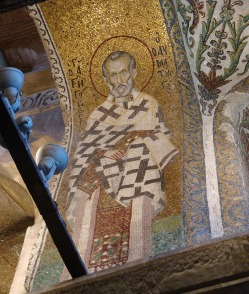
The building appears to have started life in the 12th century but had a parecclesion (side chapel) added in the 14th century. This was embellished with mosaics that are only less impressive than those in the Chora Museum because there are fewer of them; the Pantocrator in the dome, for example, is breathtakingly beautiful and completely intact.
A little further east along Fethiye Caddesi, a turning on the right leads to the Hırami Ahmed Paşa Cami which started life as St John the Baptist in Trullo, probably in the 12th century. For over 100 years until 1586 it served as a convent for nuns who had had to move out of the Theotokos Pammakaristos complex to make way for the patriarchate. Compared with Theotokos Pammakaristos it is nothing to write home about although his Byzantine origins are still apparent in the architecture. You can usually only access it at prayer times.
Continuingalong Fethiye Caddesi towards conservative Çarşamba you will see on the left-hand side of the road the elegant brick-built Murad Molla Kütüphanesi (library), built in 1775 and once part of a complex that included a tekke (dervish lodge).
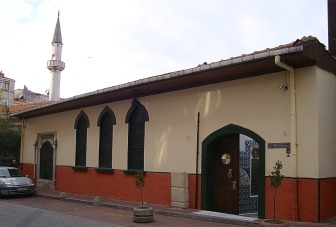 Nurettin TekkesiAnother way to find Karagümrük is to walk north along Nurettin Tekkesi Sokaği from Fatih’s Fevzi Paşa Caddesi, the main drag. This leads to the wonderful Nureddin Tekkesi, built to accommodate dervishes belonging to the Cerrahi sect.
Nurettin TekkesiAnother way to find Karagümrük is to walk north along Nurettin Tekkesi Sokaği from Fatih’s Fevzi Paşa Caddesi, the main drag. This leads to the wonderful Nureddin Tekkesi, built to accommodate dervishes belonging to the Cerrahi sect.
Today it is still used by whirling dervishes and on Monday nights it’s possible to see trainee dervishes going through their paces here and to attend one of the semas. Many of the dervishes are buried in a hall decorated with glorious lamps and with a mixture of carpets and sheepskins on the floor. Sadly, you can’t go inside although you can admire it through the side windows.
At the end of the road you will come to Fatih Nişancı Caddesi. Turn right at the end and you will come to the splendid Nisancı Mehmed Paşa Cami, indistinguishable in many ways from a Sinan mosque although it is not listed as one of his designs. It had to be substantially rebuilt in 1766 after an earthquake. Further along the road is the small Kumrulu Cami (Dove Mosque) where Atik Sinan, the architect of the Fatih Cami, was buried. He is believed to have been executed by Fatih Sultan Mehmed. The mosque takes its name from a piece of Byzantine marble embedded in the walls. Otherwise it has been so crudely restored that it’s of little interest.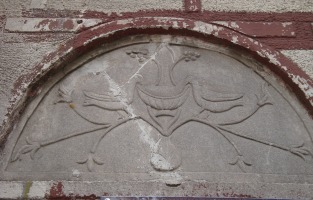 Byzantine doves set in wall of Kumrulu Cami
Byzantine doves set in wall of Kumrulu Cami
If instead you turn left at the end of Nurettin Tekkesi Sokağı you will come to a very attractive road junction where a decorative fountain (1681), the restored Halil Efendi Medrese (1575) and the small Üçbaş Cami (Triple-headed Mosque) come together (1533).
Transport info
Buses from Eminönü run to the western end of Fevzi Paşa Caddesi whence the Chora Church is a short, level walk. You can get off the same bus at the start of Nurettin Tekkesi Sokağı too.
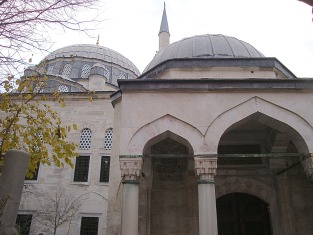 Nisancı Paşa CamiNearby areas
Nisancı Paşa CamiNearby areas
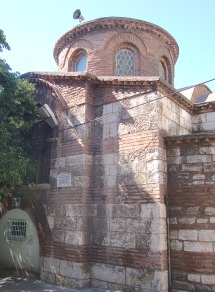 St John the Baptist in Trullo
St John the Baptist in Trullo


